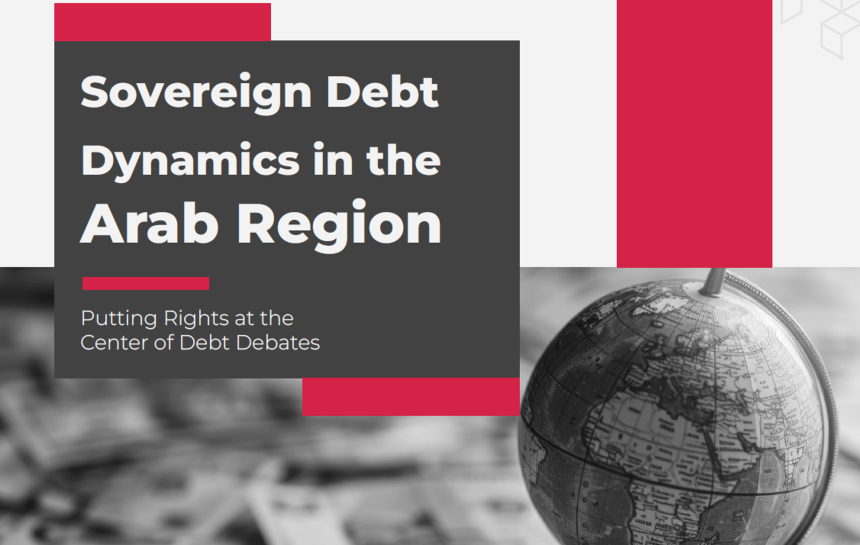
Regional Policy Report on Sovereign Debt Dynamics in the Arab Region: Putting Rights at the Center of Debt Debates
Introduction
Public debt, often approached with caution, can be a beneficial tool for advancing the public good and safeguarding social and economic rights. Governments borrow money for various reasons, including financing infrastructure projects, stimulating economic growth, as well as addressing emergencies (UNDP 2020).
During periods of economic downturn, public debt can be used as a counter-cyclical fiscal policy to inject liquidity into the economy, stimulate aggregate demand, and help an economy mitigate the adverse effects of a recession. This was evident during the 2007-08 financial crisis as well as the Covid-19 pandemic, where many governments increased borrowing to fund stimulus packages that helped their economies and societies cope with economic and health crises (Blanchard et al. 2010; IMF 2021). It can also be pivotal in advancing intergenerational equity. For instance, debt-financed investments in infrastructure, health and education, as well as climate change adaptation and mitigation can have significant positive externalities that benefit both current and future generations (Barro, 1979; Gramlich 1994).
However, rapidly growing debt levels may serve as a warning signal. Global public debt, which includes both domestic and external general government debt, reached US$102 trillion in 2024, about 93% of global GDP, marking a US$5 trillion increase from 2023 (UNCTAD 2025). It is projected to rise to 100% of GDP by 2030, surpassing the pandemic peak and significantly increasing financing needs (IMF 2025). The rapidly growing public debt represents a disproportionate burden on the developing world.
Today, low-income countries (LICs) and many middle-income countries (MICs) continue to struggle under heavy debt burdens, undermining their ability to create the conditions necessary for realizing economic and social rights, including the right to development. This challenge is further intensified by the sharp rise in global financing needs, both to address a series of complex, interlinked crises and to advance progress toward the Sustainable Development Goals (SDGs) and climate commitments. According to the 2023 World Investment Report (UNCTAD 2023b), developing countries face an annual investment gap of $4 trillion to achieve the SDGs by 2030, a significant increase from the pre-pandemic estimate of $2.5 trillion. In 2023, developing countries faced a second consecutive year of net resource outflow, paying $25 billion more in debt servicing to external creditors than they received in new disbursements (UNCTAD 2025), a negative net resource transfer that poses serious risks to development and ultimately shifts the burden onto people. This widening financing gap is further compounded by a decline in international project finance, as well as a global shift in spending toward militarization and defense, which continues to divert capital away from development priorities and exacerbate the financing gap (UNGA 2024).
In the Arab region, public debt trends broadly mirror global patterns. Over the past decade, public debt has risen sharply, reaching USD 1.5 trillion in 2022, around half of regional GDP (UNCTAD 2025). MICs such as Algeria, Egypt, Jordan, Lebanon, Morocco, and Tunisia accounted for approximately half of this total, with their combined debt standing at USD 699 billion in 2022 . LDCs, including Comoros, Djibouti, Mauritania, Somalia, Sudan, and Yemen, continue to face significant debt-related risks despite having benefited from some debt relief earlier in the decade (UNCTAD 2023). Debt service costs have also grown relative to exports and government revenues. In 2021, at least half of Arab countries spent more than 9.3% of their exports and 9.4% of their government revenues on external debt service (UNCTAD 2023). These pressures heighten liquidity constraints and limit the resources available for development spending.
Rising debt levels in the Arab region have raised concerns among stakeholders, including civil society organizations (CSOs), about the sustainability of fiscal conditions. Growing debt service obligations are limiting governments’ ability to fund essential public services and development priorities. The resulting fiscal constraints risk deepening social and economic challenges, highlighting the urgent need for a more sustainable, rights-based approach to debt management, supported by stronger international cooperation to protect development and social stability, and uphold economic and social rights.
This paper examines the evolving landscape of sovereign debt in the Arab region, analyzing key trends and sustainability challenges in comparison with global patterns. It analyzes the determinants of debt buildup in the region, provides a rights-based critique of current international debt resolution frameworks, and explores alternative approaches that move beyond austerity-driven conditionality. The paper also underscores the importance of domestic resource mobilization in achieving sustainable debt outcomes and highlights the role of civil society in advancing a more equitable and effective global debt governance framework.
The structure of this paper is as follows. The next section explores major trends in sovereign debt across the Arab region in relation to global patterns, highlighting the main challenges to debt sustainability. Section three examines the human rights implications of debt buildup and provides a rights- and development-based critique of current debt sustainability frameworks. Section four analyses the key drivers of rising debt, looking at both domestic political economy factors and external determinants, including the unequal structure of the international financial system. The final section concludes with key policy implications.